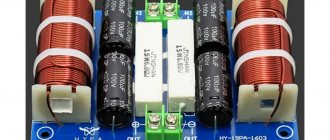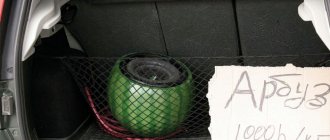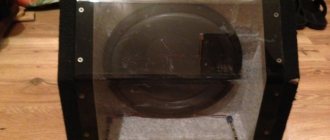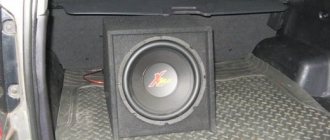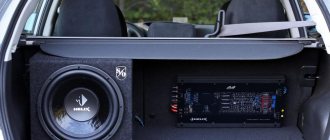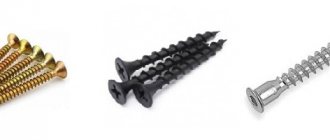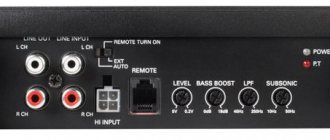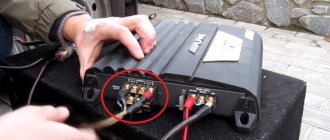Subwoofer, One of the most important components of a multi-channel speaker system, its presence is mandatory in the set of a speaker system for a home theater. Let's figure out what a subwoofer is and define its functions and purposes. Main classifications: a) active subwoofer b) passive subwoofer
A subwoofer is a speaker designed to reproduce low frequencies that are at the lower sensitivity threshold of the human ear. The term "Subwoofer" is used to describe a system with a low-frequency driver housed in a separate housing. I would not say that the subwoofer is one of the most important components of the speaker system, outlining the lower, velvety part of the sound spectrum, since I have repeatedly achieved high-quality lows from old 2- or 3-way Pioneers, but this is individual for each user.
Terminology:
- Maximum sound pressure. Maximum subwoofer volume.
- Frequency range (Hz). The frequency range of the subwoofer can be divided into the area of deep bass 20-40 Hz, medium bass 40-80 Hz, high bass 80-160 Hz. Top models from leading manufacturers can reach listeners with frequencies of 20-80 Hz. Higher frequencies usually rely on the stereo pair.
- Crossover (cutoff) frequency. The frequency at which the spectrum is divided by the crossover. If the subwoofer has a crossover frequency of 80 Hz, then all components with frequencies above 80 Hz will be attenuated and transmitted to the speaker system, but the quality of the acoustics plays a role here.
- Sensitivity (dB). The more sensitive the dynamics, the less the amplifier is loaded, the greater the sound pressure it produces at the same power.
The subwoofer formula is that the larger the area, and therefore the size of the diffuser, the more powerful and organic the bass.
The dimensions of the subwoofer are quite large. Basically, the subwoofer body is cubic in shape and made of standard materials for acoustics, for example MDF board made from wood fiber chips, made at high pressure and temperature. You can also find cylindrical and spherical systems, but they are not widely used. The low-frequency diffuser is located inside the subwoofer housing, and it is worth noting that the stroke of the speaker emitter can reach up to 7 centimeters! Subwoofers are divided into active and passive. The active ones already have an amplifier with them, and the passive one needs to be connected to a separate sound amplifier, the function of which is to amplify and transmit the signal to your Hi-Fi equipment (acoustic speakers, home theater speakers).
The main thing is your perception of the music and your feelings. Rely on them, and the chosen acoustics will delight you every time you listen. With the right choice, even inexpensive components can achieve maximum quality; all that is needed is a balance between them.
Rework
How to make a passive subwoofer active
Some users, in order not to overpay for an active subwoofer, decide to make one themselves from a passive one. The idea is interesting and fully justified in practice.
Note. Converting a passive subwoofer into an active one involves connecting it to a power amplifier and crossover, which must be built into the speaker. Only this setting requires specific knowledge.
Calculation of indicators
Rework according to the scheme
If we were making an active subwoofer completely from scratch, then first of all, we would need to download from the Internet or find another way a program for calculating acoustic designs.
Note. For example, it could be a GBI Speaker, which includes two more independent graphic schemes that are needed to determine the required volume and size of the housing, and also allow you to independently select two directions for the housing.
In addition, it would be necessary to find the known Thiel-Small values. By the way, they are needed in our case as well.
Known Thiel-Small parameters
The fact is that the emitters installed in the speakers may not meet the above parameters. And then everything will have to be measured again.
Measurement
Started:
- First, the resonant frequency Fs is measured. This parameter specifies the frequency without any additional decoration. Fs is calculated as follows: the emitter is suspended in the air at a great distance from foreign objects so that this value is not influenced by external characteristics;
- It is better to measure the resonant frequency in a vacant garage or other room. We hang the speaker on the ceiling;
- Open the Tone Generator program on your computer;
- The initial frequency is set to 10Hz, and then the frequency gradually increases in 1Hz steps. At the same time, you need to look at the voltmeter readings. Thanks to the graph below, you can determine the required value;
Resonant frequency graph
- The approximate speaker frequency Fs in 1Hz steps will be the maximum value of the voltmeter;
- To calculate the exact value, you will need to change the frequency not by 1Hz, but by five hundredths of it.
Note. Some people believe that a very low resonant frequency is ideal for a subwoofer. This is true, but partially, because for some designs such a low resonance can lead to interference.
Second meaning
- Then the total electromechanical quality factor Qts is measured. Interestingly, the quality factor has two indicators: mechanical and electrical. The first is determined by the choice of suspension material. Quality factor is often measured using a makeshift method: shaking. The low quality factor of the subwoofer is 0.3/0.35, and the high value is 0.5/0.6.
- The electromechanical quality factor is found using the formula, where the values will be two components, one of which is lower than the resonant frequency, and the other is higher.
Subwoofer frequency response
Equivalent Volume
Finally, the third value we will need to calculate is the equivalent volume Vac:
- To determine such a volume, you will need a bass reflex box with a hole. In a passive subwoofer from the manufacturer, the volume of such a box is already agreed upon in comparison with the diameter of the speaker. Therefore, there is no need to do anything extra;
- Again, using the Tone Generator program we determine the value, as in the case of the resonant frequency. Only calculations are carried out using the following formula:
Formula for determining Vac
Hull alteration
In order to get high-quality sound, calculations alone are not enough. It is necessary to carefully prepare the subwoofer housing, converting it to the active version. What have we achieved with calculations? We determined the internal volume of the box, the length and diameter of the bass reflex.
Note. It is believed that converting a passive subwoofer into an active one is much more difficult than doing everything again with your own hands. Thus, a homemade box is made with the necessary holes.
One thing you need to know: an active subwoofer (its housing) must consist of 2 compartments. The emitter or loudspeaker is located in one of the compartments, and the amplifier, crossover and power supply are in the other.
Note. From the inside, it is recommended to glue foil to the walls of the compartment where the amplifier, power supply and isolation filter will be located. It eliminates the negative effects of external fields and minimizes noise levels.
Active subwoofer from the inside with 2 compartments
Correct connection of the subwoofer
Any amplifier/receiver is usually equipped with a special RCA output, which is designed for connecting subwoofers. Some of them have two outputs (for example, the Pioneer VSX-420 receiver described in this article). However, they usually use one output, since the second one is most often designed so that a second subwoofer can be connected. To connect the subwoofer, you need an RCA cable to connect it to one RCA input available on the receiver (audio cables are described here).
Equalizer settings
High-quality acoustics are of great importance for every user of a personal computer or laptop. A special equalizer can give your favorite music and movie soundtracks a really good sound.
Before you start setting up the equalizer, you should check that the audio system is correctly connected to the sound card. Also check whether all drivers and other pre-installed software required for audio are functioning correctly.
You can use a standard equalizer; it is built into every Windows operating system; however, third-party equalizers, as a rule, have wider functionality and quality of sound correction. Let's look at how to use the built-in equalizer and which third-party programs are worthy of your attention.
The process of setting up the built-in equalizer:
- Go to the Sound menu in the Computer Control Panel (this step is described in more detail in the first paragraph of the article).
- On the menu tab called Playback
- From the list of audio devices that appears, select the speaker. Open the speaker menu.
- In the window that opens, select the properties item - it will open another window.
- In the new window, select the tab called levels. A menu for adjusting various sound parameters of the audio system will open. Setting up sound on a computer involves changing the parameters that appear. In this menu you can configure the sound separately for each of the two connected speakers. Try to set the most pleasant sound level.
- Go to the Improvement tab. In the list of checkboxes that appears, check the equalizer box. After completing this action, you will have access to the sound card equalizer control function. All changes will be automatically saved by the system. You can also return to the original equalizer settings.
The standard settings window for the built-in equalizer in the system looks like this:
The equalizer settings are quite extensive and allow you to customize the sound according to the type of room and personal sound preferences.
Third-party software for setting up your computer's equalizer:
- Equalizer APO. A program with wide and advanced audio equalizer functionality. Suitable for Windows operating systems. The program provides the user with the opportunity to work with a huge number of sound filters and channels. The option to connect to related audio programs is available. The utility does not load the processor, but allows you to quickly adapt the sound level according to the personal preferences of the PC user.
- The program is a sound equalizer that is designed to be placed on the operating system desktop. Allows you to customize the sound according to the type of room and displays sound vibrations directly on your desktop.
How to properly connect a subwoofer: general information
- A special linear output of the amplifier or receiver is connected to the linear input of the built-in RCA subwoofer amplifier (tulip). This input may be "stereo". Inside the subwoofer, the signals from these inputs are usually mixed or sent to 2 different amplifiers. Some subwoofers have a double-coil speaker with the coil itself having two windings. A separate amplifier is connected to each winding. If your receiver has one RCA connector for connecting a subwoofer, then the receiver (amplifier) is connected with the double end of a Y-shaped cable (1 RCA to 2 RCA) to the two line inputs of the subwoofer (its inputs are paralleled).
- A stereo power amplifier or receiver without a special linear output to the subwoofer is used, then the connection occurs through the terminals on the subwoofer - its inputs (bypassing the built-in amplifier). The left and right terminals of the amplifier are connected with an acoustic cable to the terminals of the subwoofer - its inputs, parallel to the front speakers.
Testing and adjusting sound in speakers
If the speakers are working, but the sound leaves much to be desired, you need to configure it using standard tools of the MS Windows operating system. To start testing and adjusting sound parameters, go to the system control panel using the Start menu.
Go to the sound menu (to speed up the process of finding the desired icon in the control panel, use the instant search in the upper right corner). Select the desired speakers from the list of installed sound devices and check in the options whether the drivers are installed correctly (if not, reinstall them) and whether they are connected correctly.
Test the sound at different volumes to check for excessive hiss or other interruptions in the sound.
If your speakers have a built-in microphone, be sure to check the sound recording quality. This can be done using a very ordinary voice recorder. If such a program is not in the list of standard pre-installed software on your OS, you can download third-party software. Good analogues to a standard voice recorder are the programs EasyRecorder, RecordMe, StartRecord. Before launching the program and recording anything, check whether the microphone is enabled in the sound settings (system control panel - sound).
Connecting an active subwoofer to the receiver
I won’t immediately fill your head with possibly unnecessary information, but first I’ll present 3 options for connecting an active subwoofer to a receiver/amplifier or DVD/Blu-Ray player. It is possible that your subwoofer only has one “Subwoofer” input, but the diagram below shows the most common option.
The subwoofer has two high-level inputs, so for connection you will need a fairly thick and long speaker cable in order to connect to the amplifier.
There are several ways to connect a subwoofer:
Active subwoofers (with a built-in amplifier) are connected with a coaxial cable RCA - RCA, in other words (tulip-tulip). One end of the cable goes to the subwoofer, the other to the 6-channel analog panel on the receiver in the connector labeled Subwoofer. If there are 2 RCA connectors on the subwoofer (L and R - In) or 4 (L and R - In and Out), then a white connector is used.
To connect a subwoofer, you can use the output terminals that are used to connect speaker systems. In this case, the subwoofer and speaker systems will operate in the low-frequency range in parallel.
The subwoofer is sometimes connected to the output terminals located on the amplifier, then the speakers are connected to the high-level output terminals located on the subwoofer. The fact is that in front of these terminals there are 6 dB high-frequency filters, which reduce the pressure in the low-frequency range exerted on the speaker systems. At the same time, the devices do not operate in parallel, in other words, this connection method allows you to increase the workload exerted on the entire system.
Below the bottom
Owners of bookshelf speakers may at some point realize that something is missing from their sound, and most likely it will be bass. A special speaker - a subwoofer - can come to the rescue, creating sound in the low-frequency range. However, you should not assume that it will immediately solve all problems - this is a rather difficult device to install, and choosing the right model is not at all easy.
In the Hi-Fi sphere, the most common are active subwoofers that have a built-in amplifier, which is not surprising, because not every component device can cope with a large low-frequency speaker. We will give several recommendations on their selection, installation, connection and configuration.
Connecting a passive subwoofer to an amplifier
If the subwoofer has two terminals on the back, then the subwoofer is connected to the Pre Out Subwoofer through an amplifier. Thus, the connection diagram looks like this: Subwoofer - Speaker cable - Amplifier (especially for a subwoofer) - RCA cable - Receiver (Pre Out Subwoofer) .
In other words, the subwoofer can be connected through a separate amplifier, using the Pre-out subwoofer output located on the rear panel of the receiver. Connect the subwoofer to any amplifier, and connect a passive subwoofer to the speaker output of this amplifier using an acoustic cable.
Attention! Remember to set the “cutoff” (cutoff frequency or limit of reproduced frequencies) in the receiver to the subwoofer and adjust only the overall volume of the entire speaker system, since you can ruin the subwoofer by using the subwoofer amplifier control.
Very often, passive subwoofers are connected in parallel to the front speakers:
- There are three terminals on the back panel of the subwoofer - these are the pluses from the front speakers and their common minus (the minuses are twisted together);
- There are four terminals on the back of the subwoofer - these are the pros and cons of the front speakers.
The passive subwoofer can also be used in stereo. It is also perfect for connecting to a home theater. When used in conjunction with a stereo amplifier, you need to connect the amplifier outputs to the subwoofer outputs. For these purposes, it is convenient to use speaker cables that have a thickness of 2.5 to 4 mm; you just need to select the desired length. When connecting, it is important to ensure that the poles of the plugs match the poles of the provided channels. The subwoofer outputs are connected to satellites. A similar operation is performed when the subwoofer is used in a home theater.
How reliable is the Chevrolet Aveo?
Chevrolet Aveo 1.2 covered only 57,500 km in 6 years. During the first 50,000 km, the only problem was a leaking shock absorber, which was replaced under warranty, but over the last six months, minor troubles have appeared in a series. First, oil leaked from the engine. Fortunately, the leak was eliminated by replacing the oil filter (RUB 1,000 including labor). Then the cooling system burst, and there was a lot of bloodshed here. The official dealer did not offer any options other than replacing the radiator, which together with coolant and work cost 9,200 rubles.
Aveo skidded on level ground when leaving the parking lot. The right rear wheel turned out to be blocked. I had to look for an opportunity to repair the immobilized car right in the yard. It’s difficult to do it on your own: you can’t remove the brake drum without a special tool. A mechanic from a nearby service center agreed to leave his workplace for 1,000 rubles. When removing the drum, it was discovered that the friction lining had come off the shoe, jamming the wheel. It should be noted: the wear of the pads turned out to be no more than 15%. But I had to buy a set of new ones (950 rubles from an official dealer).
Replacing the front wheel bearing in an Aveo may be necessary starting at 100 thousand km (there have been cases when wheel bearings lasted 190 thousand km). However, experts recommend that Aveo owners check for possible problems in the operation of the wheel bearings during each maintenance. To do this, it is enough to jack up the car and check for play in the wheel, and then spin it as you move (the wheel should rotate without tension and silently, if the wheel rotates tightly or a sandy crunch is heard, and a hum is heard while driving, then this indicates need to replace the wheel bearing).
In general, the costs of unscheduled repairs can be called very moderate, but in the near future, apparently, quite expensive operations are expected. The suspension that suddenly began to rattle clearly hints at this.
Basic principles when choosing a subwoofer
Many believe that a system with a low-frequency head located in a separate housing, which reproduces sound together with small satellites, is a subwoofer. This is wrong. The meaning of the term “subwoofer” is “below the woofer head”. A subwoofer is a separate acoustic system for reproducing the lower frequencies of the audio range, reducing the lower limit frequency to 20 Hz and below.
The main types of subwoofers: a) active; b) passive. The first type includes models equipped with a built-in amplifier. Their advantage is the unloading of the main home theater amplifier. In this case, the subwoofer requires additional power. The second type includes models that need to be connected to an external amplifier. There are several options for connecting a passive subwoofer. When the receiver supplies a signal to the main speakers and the subwoofer at the same time, the wideband output signal is transmitted to the subwoofer input. In this case, an additional separation filter (crossover) is used, which separates high and low frequencies and delivers filtered signals to the destination (low-frequency to the subwoofer, high- and mid-frequency to the main satellites).
A passive subwoofer has a number of disadvantages, as a result of which their cost is lower than that of active ones. A serious drawback is the need to accurately match the subwoofer with the existing speaker system. This is a very complex process. Connecting a subwoofer using a separate power amplifier and an electronic crossover filter will reduce nonlinear distortion due to the fact that the signal is divided according to a special circuit. And besides, the main amplifier is freed from increased load.
Recently, almost all active subwoofers have the ability to adjust the crossover frequency, so when using this subwoofer connection model, the procedure for matching the main components of the system becomes much simpler. As a disadvantage, we can note the rather high cost of active subwoofers. Despite this, when choosing, I advise you to take a closer look at active ones that have an internal amplifier. If you don't want to spend a lot of money on a subwoofer, take a look at Yamaha's budget models.
Now a little about the electronic filling
The device is almost the same, except that the dimensions are larger, the microcircuits or capacitors may be in a different order:
- Let's take a closer look at the voltage converter, power supply and amplifier
- The ceratec subwoofer amplifier is usually two-channel, but two channels are connected to one single dynamic head
- Moreover, each channel in the amplifier amplifies a different sound frequency, low and medium, as a rule
- In addition, almost all modern amplifiers operate on a single chip from the TDA series
- To get more power at the output of the amplifier, twelve volts from the on-board network of the car is not enough; for powerful microcircuits, the supply voltage is from 40 volts
- Therefore, the bw subwoofer circuit has a built-in high-frequency converter that converts the 12 volt voltage into the voltage necessary for normal operation of the amplifier
Subwoofer without housing
- In the figure, we have divided the entire circuit into three main blocks. A1 – control of the equalizer, it fails extremely rarely, you need to try to break it, we won’t devote time to it, it changes completely
- A2 is a voltage converter, and A3 is a power amplifier. Let’s take a closer look at A2 and A3
Slightly enlarged diagram
- The voltage, through the filter, comes to capacitor C1, from there it is supplied to transistor switches VT1 and VT2
- Transistor switches are controlled by a high frequency signal generated by the DD1 microcircuit
- The amplified signal from transistors VT1-VT2 comes to transformer T1, where the voltage turns from 12 Volts to 40 Volts
- Moreover, the secondary winding of the transformer consists of two windings; for rectification, a rectifier consisting of two diodes is used
- To unload these diodes, two more diodes are installed in parallel with them
- Each of the DD2 and DD3 microcircuits is powered only by its own diodes
- To smooth out high-frequency pulses, capacitors are installed, marked C2 and C3
- Converter A2 ends here, followed by power amplifier A3
- Modern amplifiers consist of a single chip
- At its input, in order to obtain normal output parameters, a signal of a certain magnitude must be present
- The designers of this subwoofer decided that not every car radio has enough power, or rather the strength of the output signal from the primary amplifier, to obtain the nominal output parameters
- Therefore, we added a transistor to amplify the signal in front of the input of the microcircuit, in the circuit DD2 and DD3
- Here is a list of the main radio components that fail most often
- It happens that for replacing one capacitor the price in the workshop will be considerable, but the work is cheap
- Therefore, it is better to check the entire scheme yourself before paying without looking
Additionally, I recommend studying the repair video.
Connecting an active subwoofer in a car
1. Connecting the linear RCA outputs of the radio with the RCA inputs of the subwoofer ( LOW IINPUT ). You must connect with a regular RCA cable (2 tulips - 2 tulips or a pair of tulip-tulip cables). If there are no RCA outputs on the radio, connect to HI INPUT .
2. Power connection. Positive cable from the battery ( through a fuse ) to the +12V terminal of the subwoofer (power), negative cable from the battery (or from the car body) to the GND . The fuse is placed 10-20 cm from the battery.
3. Connect the subwoofer to the REM on the radio. REM - control wire. It is led from the radio to the REM terminal of the same name on the subwoofer, connected to the “blue/white” wire (see the instructions), which sticks out from the bundle of wires on the radio, usually labeled. When you turn on the radio, the supply voltage appears on it. The wire can be of any diameter, the current is minimal.
Chevrolet Epica
The fully independent suspension of the Chevrolet Epica irritates many with its rigidity. The sedan steers well, but on bumps it bounces like a ball. Users install Kayaba shock absorbers from a Toyota Camry V30, and the car is transformed on the go. Alterations will cost 10,000 rubles. But it's worth it. Now about expenses. The first to be retired in the chassis at 20-40 thousand km are the stabilizer struts (1,100 rubles each) and bushings (400 rubles each). Ball joints (1,650 rubles each) last an average of 60-80 thousand km. Original shock absorbers (3,400 rubles each) are sold at 100 thousand km. On a third of sedans, the steering rack is moping. Sometimes, up to 100 thousand km, it had to be repaired (from 5,500 rubles) several times. In any case, by 120 thousand km, it usually wears out (from 29,000 rubles). During this time, you will have to update the tips a couple of times (1,800 rubles each).
Supauto.RU is an online sale of spare parts for foreign cars. For detailed information, please call.
What characteristics should you pay attention to when choosing a subwoofer?
Often manufacturers try to show that their product is better than it actually is. They may write some unrealistic numbers on the box. But, looking at the instructions, we find that there are not many characteristics there, as a rule, because there is nothing special to brag about. However, even with this small list we can make the right choice.
Power
Now, when choosing a subwoofer, the main preference is given to power; it is believed that the more powerful the equipment, the better. Actually this is not entirely true
Let's figure out what power you should pay attention to
Peak (MAX) As a rule, the manufacturer likes to indicate it everywhere, and these are some unrealistic numbers. For example, 1000 or 2000 watts, and for little money. But, to put it mildly, this is a hoax. There is no such power there. Peak power is the power at which the speaker will play, but only for a short time. There will be horrific sound distortion. Unfortunately, in this mode, the subwoofer’s task is not to provide high-quality sound ─ but just to survive for a couple of seconds.
Rated (RMS) The next power we'll look at is rated power, which may be referred to as RMS in the instructions.
This is the power at which sound distortion is minimal, and the speaker can play for a long time without causing harm to itself, this is what you should pay attention to. No matter how strange it may sound, but, for example, when comparing a powerful and weak subwoofer, the weak one can play louder than the powerful one
That is why power is not the main indicator. It shows how much power the speaker is using, not how loud it is playing.
Sensitivity
Sensitivity is the ratio of the diffuser area and its stroke. In order for a speaker to play loudly, it needs a large cone and a large stroke. But often manufacturers make a huge dewlap, an impressive lip. People think that a speaker has a lot of excursion and plays louder, but in fact it loses to speakers with a larger cone. You should not give preference to subwoofers with a large lip; it loses to a small one, because a speaker with a large diffuser has a higher efficiency. Thus, a large stroke is nice, but the diffuser area is much more useful.
This indicator is measured as follows. They take a speaker, place a microphone at a distance of one meter and strictly apply 1 watt to the speaker. The microphone records these readings, for example, for a subwoofer it can be 88 Db. If power is consumption, then sensitivity is the output of the subwoofer itself. By increasing the power by 2 times, the sensitivity will increase by 3 decibels; a difference of 3 decibels is considered a 2-fold increase in volume.
Now you understand that power is a minor indicator. Let's take an example: the first subwoofer has a rated power of 300 watts and a sensitivity of 85 decibels. The second one also has 300 watts and a sensitivity of 90 decibels. 260 watts were supplied to the first speaker, and 260 watts to the second, but the second speaker, due to its greater efficiency, will play an order of magnitude louder.
Resistance (impedance)
Basically, all car cabinet subwoofers have a resistance of 4 ohms. But there are exceptions, for example, 1 or 2 Ohms. Resistance affects how much power the amplifier will deliver; the lower the resistance, the more power the amplifier will deliver. Everything seems to be fine, but in this case it begins to distort the sound more and heat up more.
We recommend choosing a resistance of 4 Ohms ─ this is the golden mean between quality and volume. If the active subwoofer has a small resistance of 1 or 2 ohms, then most likely the manufacturer is trying to squeeze the maximum out of the amplifier, without paying any attention to sound quality. This rule does not work in loud systems, and in SPL competitions, instead, low impedance is used to get maximum volume from the system.
Adjusting the sound of headphones connected to the audio system
Headphones are also an element of the audio system. Their sound is very easy to tune even for an inexperienced user. To start setting up headphones connected to your computer, follow the instructions below:
- Go to your operating system desktop.
- On the toolbar, right-click on the speaker icon.
- From the proposed menu, select the tab under the name of the playback device.
- In the window that opens, select the sound playback tab and configure the parameter as you wish, or apply standard settings by checking the “Default” checkbox.
If you are using wireless headphones, make sure that the system recognizes and installs them automatically, otherwise install all the drivers yourself. This can be done by using the installation disk or downloading the necessary software from the website of the manufacturer of your headphones.
